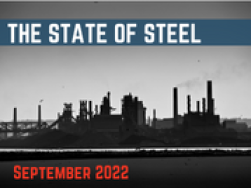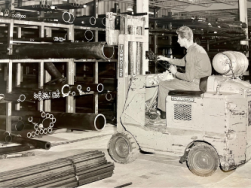State of Steel - September 2022
Pricing - Have we hit bottom on Structural Steel Pricing?
Steel tube pricing continues to be conflicting and confusing. Hot-rolled coil prices in the United States hovered around $40 per hundredweight in the first week of September, with market participants increasingly agreeing that this level indicates a new price floor for domestic hot band. This coil is the raw material used when producing structural tubing. Sources largely agree that the series of price hikes announced by domestic steelmakers have put a price floor on the hot band market. With that in mind, we could be at the bottom with regards to structural tubing pricing. Mills are continuing to quote Price in effect when “Ready” to ship and have done so since June 1st, 2022.
While structural tube pricing declines, mechanical tubing pricing remains elevated and lead times continue to be very long, and order books have been closed at many mills since mid-Summer. Mechanical tubing (dom, hrs, cds) mills are struggling to keep up with demand due to labor shortages, strong demand, and a limited supply of tube hollows and bars. Because of these factors, the pricing looks to continue to stay quite high. Most lead times for hot rolled seamless, cold drawn seamless, and drawn over mandrel tubing are well into the middle of next year! The below charts reflect the CRU index and a current listing of all price increases/decreases on tubing that we have seen since late August of 2020.
Effective August 24th, 2022, Cliffs announced a $75/ton increase on all base prices for any new orders for sheet and coil. Cliffs rival Nucor raised sheet prices by $50/ton in early August, its first increase since February. These increases have appeared to stick and should be a tell-tale sign that we have hit the bottom. Another indication of that is the CRU index flattening out and increasing this week over last week.



Cast Iron Pricing
September did not see any base increases for cast iron. Since January of 2021, Dura-Bar has increased their base prices a total of 5 times. Surcharges appear to have topped out in May as we have now seen surcharge decreases three months in a row. Assuming Dura-Bar does not increase their base pricing again, we should continue to see some relief in pricing based on surcharges declining. The below chart details the Dura-Bar surcharges over the last year or so.

Scrap & Steel Inputs
Ahead of the September scrap buy week, most market sources continue to expect shredded scrap prices to be unchanged month-over-month, following four consecutive months of declines, with some sources flagging risks of another monthly decline given more than 10 steel mills are scheduled for maintenance while the export market remains sluggish. However, shredder feed flows have slowed, providing some support for prices. (Source: AMM) On Wednesday at least two mills reportedly canceled outstanding scrap deliveries for August on expectations that prices for September have greater potential to fall than increase, indicating the direction of scrap prices in September remains uncertain. (Source: Platts)
Metal Production
In the week ended August 27, US raw steel production decreased 0.5% week-over-week to 1,747,000 tons (-6.7% YoY). US capacity utilization was 79.3% vs 84.8% last year. Year-to-date production is 59,715,000 tons down 3.4% year-over-year from 61,832,000 tons last year. (Source: AISI)
Lead Times
Understanding lead times for steel products are important to every participant in the supply chain. Lead times for steel products are as follows (as of 09/08/22):
Average HRC lead times were flat last week at 4.8 weeks, which is below the average of 5.6 weeks since 2016. Other product lead times were flat to longer last week with CRC lead times at 6.7 weeks, HDG lead times at 7.0 weeks, and plate lead times at 4.9 weeks. (Source: Platts)
DOM, HRS, and CDS Tubing lead times continue to be very long and are anywhere from 30 to 45 weeks primarily now due to backlog, contract business, and labor shortages. We continue to see lead times be long and are now seeing availability not free up until mid-2023.
Structural Tubing mill lead times are steady and running approximately 3-5 weeks upon receipt of order. Common sizes we can get sooner for now.
Dura-Bar Continuous Cast Iron mill lead times are approximately 6-10 weeks depending on size, grade, and finish. If it’s a large bar, special grade, size, or shape then the lead time could be considerably longer.
Oil & Gas Industry
The US rig count increased 0.4% week-over-week to 765 rigs as of 8/26. The rig count is up 50.6% year-over-year. (Source: Baker Hughes) OPEC said Monday it would reduce oil production next month, the cartel's first output cut since the depths of the pandemic, as it braces for a global economic slowdown to hit demand. (Source: CNN Business)
Economic Factors
Unit labor costs, or the amount of compensation compared to output, rose 10.2% for the quarter, 0.4 percentage points less than estimated. However, the four-quarter increase of 9.3% is the highest level since the first quarter of 1982. This is the result of higher wages and declining productivity, both of which are contributing to sustained inflationary pressures. Productivity declined by 4.1% during the quarter. (Source: CNBC) According to a recently released analysis, the American iron and steel industry is a dynamic part of the U.S. economy, accounting for more than $520 billion in economic output and nearly two million jobs in 2017 when considering the direct, indirect (supplier) and induced impacts. These workers earned over $130 billion in wages and benefits. All told, the industry generated $56 billion in federal, state, and local taxes. (Source: AISI)
Imports/Exports
Based on preliminary Census Bureau data, the American Iron and Steel Institute (AISI) reported today that the U.S. imported a total of 2,672,000 net tons (NT) of steel in July 2022, including 2,274,000 net tons (NT) of finished steel (down 5.7% and up 2.1%, respectively, vs. June 2022). Total and finished steel imports are up 10.4% and 31.8%, respectively, year-to-date vs. 2021. Over the 12-month period August 2021 to July 2022, total and finished steel imports are up 35.7% and 47.1%, respectively, vs. the prior 12-month period. Finished steel import market share was an estimated 25% in July and is estimated at 25% over the first seven months of 2022. (Source: AISI)







